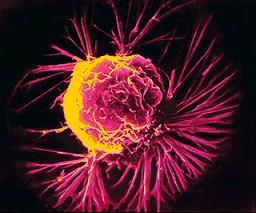| Cancer has a highly emotional impact on the patient who is diagnosed with the disease, and on his or her family. Most health care providers in the United States try to provide substantial medical and nonmedical support for both the patient and family. Many health care providers have developed comprehensive cancer centers to provide expert management of patients with cancer. The centers provide resources and information for both patients and the physicians treating them.
Methods for treating cancer include surgery; radiation therapy; and drug therapy. Most cancer treatment plans combine several or all of these methods in a technique called multimodality therapy. Physicians may use biological response modifiers to enhance a patient's ability to fight cancer. However, some cancer patients seek nontraditional or alternative treatments.
Surgery is the main method of treating most types of cancer. Cancer surgery chiefly involves taking out the tumor while minimizing the removal of healthy surrounding tissue. Surgeons work closely with a pathologist (expert on tissue changes) who can examine tissue during the surgery to determine if the tumor has been completely removed.
Surgeons may also cut out additional tissue that appears healthy. For example, breast cancer may be treated with a lumpectomy, an operation that removes the cancerous lump and a margin of the normal tissue surrounding it. Neighboring lymph nodes may also be removed and examined for signs of cancer. Although these nodes may appear normal, they might contain cancer cells that could travel to other parts of the body.

Breast Cancer
Radiation therapy, also called radiotherapy, attacks cancer cells with X-rays or other high energy particles from radioactive substances. Radiotherapy is often used to treat cancers of the bladder, prostate, head, and neck. Radiation kills cancer cells, but it also kills normal cells.
One type of radiotherapy, called external beam radiotherapy, sends X rays into the target tissue to destroy cancer cells. Machines called linear accelerators produce the X rays at increasingly greater energy. The higher the energy of the X rays, the deeper the beam can penetrate into the body to reach cancer tumors.
Drug therapy, also called chemotherapy, is used against a wide variety of cancers. Chemotherapy has proved especially effective in treating leukemia, lymphoma, and testicular cancer. Cancer cells divide much more rapidly than normal cells. Therefore, many cancer drugs are designed to interfere with cell division. Chemotherapy causes side effects by injuring the normal body cells, especially those that divide most rapidly. Rapidly dividing normal cells include blood-forming cells, cells that line the intestines, and hair-forming cells. Damage to blood-forming cells may increase a patient's risk of developing anemia or an infection. Injury to intestinal cells may cause nausea and vomiting. Disruption of hair-forming cells can cause hair loss. Researchers work constantly to develop drugs that reduce harm to normal cells.
Multimodality therapy involves some combination of surgery, radiotherapy, and drug therapy. In the most common multimodality therapy, doctors prescribe drug therapy to follow surgery, radiotherapy, or both of those treatments. Such follow-up treatment is called adjuvant drug therapy. Because the drugs reach all parts of the body, they may destroy cancer cells that have spread undetected to distant organs. Adjuvant drug therapy is used to treat some colon and breast cancers as well as some bone cancers.
|

